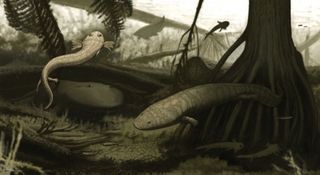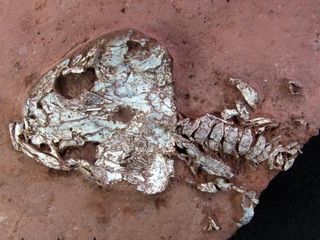Ancient Brazilian Lake Offers Trove of Amphibian Fossils

A mishmash of ancient amphibians and reptiles once swam and hunted prey in an ancient Brazilian tropical lake, a new study finds.
However, few of these animals are known to science, said the researchers who recently excavated fossils from the 278-million-year-old lake. Their findings reveal two new species of amphibians that lived during the Early Permian on Gondwana, a supercontinent that included Africa, South America, Australia, Antarctica, the Indian subcontinent and the Arabian Peninsula.
The findings also shed light on how ancient animals moved around Gondwana in prehistoric times, the researchers said. [In Photos: Giant Amphibian Ruled Ancient Rivers]
"Almost all of our knowledge about land animals from this time comes from a handful of regions in North America and western Europe, which were located near the equator," study co-researcher Ken Angielczyk, an associate curator at the Field Museum in Chicago, said in a statement. "Now we finally have information about what kinds of animals were present in areas farther to the south, and their similarities and differences to the animals living near the equator."
The researchers named the new amphibian species Timonya annae (tih-MOAN-yuh ann-AYE), in reference to Brazil's Timon municipality and Ann Warren, a specialist in Temnospondyli, a diverse group of primitive, four-legged amphibians.
Timonya was an aquatic carnivorous predator that had fangs and gills, and looked like a cross between a modern Mexican salamander and an eel, the researchers said. They found several specimens of Timonya, including skulls and skeletons, most of them juvenile.
The other newfound species is named Procuhy nazarienis (pro-KOO-ee naz-ar-ee-en-sis), from proˆt (frog) and cuhy (fire) in the local Timbira language, a reference to the local Rock of Fire formation that got its name from the presence of flint. Nazariensis honors the Nazaria municipality, where the fossils were uncovered.
Sign up for the Live Science daily newsletter now
Get the world’s most fascinating discoveries delivered straight to your inbox.
Procuhy likely spent its entire life underwater, the researchers said. Both Procuhy and Timonya are distant relatives of modern salamanders, they added.
The researchers also found fossils of an amphibian known as a rhinesuchid — a collie-size creature whose known closest relatives lived in southern Africa in later times, and a lizardlike reptile called Captorhinus aguti, which was only known from fossils in North America, until now.

These findings illuminate how animals spread during the Permian and colonized new areas, the researchers said. Moreover, it helps paleontologists learn more about fossils from a little-known time and place.
"Fossils from classic areas in North America and Europe have been studied for over a century, but there are long-standing questions about how different animal groups dispersed to other areas that we can't answer using just those fossils," Angielczyk said. "Exploration in understudied areas, such as northeastern Brazil, gives us a snapshot of life elsewhere that we can use for comparisons. In turn, we can see which animals were dispersing into new areas, particularly as an ice age was ending in the southern continents and environmental conditions were becoming more favorable for reptiles and amphibians."
The findings were published online Thursday (Nov. 6) in the journal Nature Communications.
Follow Laura Geggel on Twitter @LauraGeggel. Follow Live Science @livescience, Facebook & Google+. Original article on Live Science.

Laura is the archaeology and Life's Little Mysteries editor at Live Science. She also reports on general science, including paleontology. Her work has appeared in The New York Times, Scholastic, Popular Science and Spectrum, a site on autism research. She has won multiple awards from the Society of Professional Journalists and the Washington Newspaper Publishers Association for her reporting at a weekly newspaper near Seattle. Laura holds a bachelor's degree in English literature and psychology from Washington University in St. Louis and a master's degree in science writing from NYU.